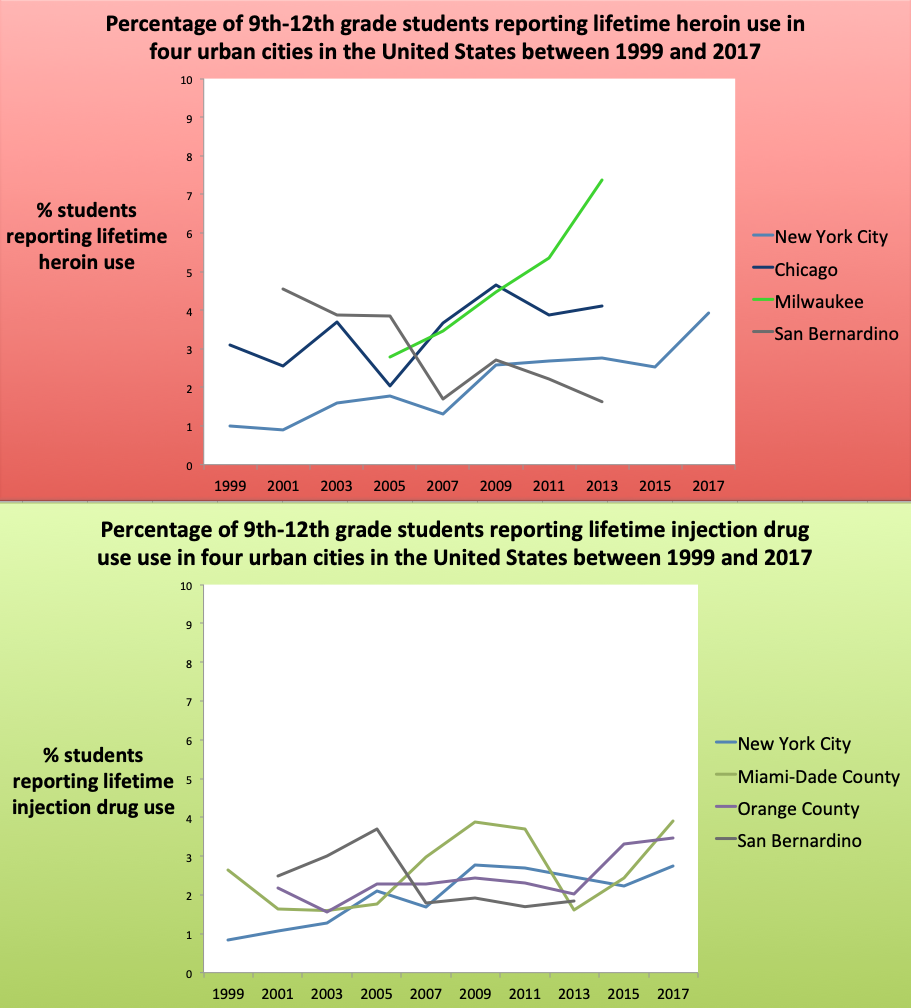Lifetime prevalence of heroin use among 12th graders in the United States has been declining since 2010. Though this is a promising finding, we know from other studies that when you look at specific segments of the population (defined by race, age, geography, and other factors), the story often looks much different. This week, STASH reviews a study by Sherri-Chanelle Brighthaupt and her colleagues that examined the prevalence of adolescent lifetime heroin and injection drug use in major American cities.
What was the research question?
How did the lifetime prevalence of heroin and injection drug use (IDU) change among high school students in major American cities from 1999 to 2017?
What did the researchers do?
Brighthaupt et al. used data from the Youth Risk Behavior Survey (YRBS), a national school-based survey that assesses health behaviors including adolescent substance use. They analyzed data from nine urban school districts.1 The researchers completed logistic regression analysis to assess how the prevalence of lifetime heroin and IDU use changed in each urban school district over time.
What did they find?
From 1999 to 2017, New York City, Milwaukee, and Chicago all showed significant linear increases in lifetime heroin use between 1999 and 2017. San Bernardino was the only district to show a significant linear decrease in heroin use over time. New York City, Orange County and Miami-Dade County all showed significant linear increases in lifetime IDU use between 1999 and 2017. As with lifetime heroin use, San Bernardino was the only district to show a significant linear decrease in injection drug use over time. Overall, trends in lifetime use of heroin and IDU were very similar within each city from 1999-2017 (see Figure).

Figure. Percentage of high school students in urban school districts in the United States showing significant linear increases or decreases in lifetime heroin and injection drug use from 1999 to 2017. Figure adapted from Brighthaupt et. al (2019). We use a narrow range on the y-axis so that readers can detect trends over time. Click image to enlarge.
Why do these findings matter?
This study demonstrated that national trends in adolescent lifetime heroin and IDU use masks rising use in some major American cities. It is important for public health workers to know in which cities adolescent heroin and IDU use is increasing so that they can develop and deploy targeted, culturally competent interventions. In addition, looking at San Bernardino, a city where both heroin and IDU use has been decreasing, might be very helpful in understanding what factors in urban areas are protective against drug use. These findings also provide a foundation for future research into what factors in these urban areas are contributing to adolescent drug use.
Every study has limitations. What are the limitations of this study?
The YRBS is administered in schools, therefore students who were absent or who had dropped out of school would not have been included in the survey. Since students who have dropped out of school or miss school frequently are more likely to be using drugs, it is possible that the present study underestimated the lifetime prevalence of heroin and IDU use. In addition, the YRBS did not measure nonmedical prescription opioid use (NMPO) until 2017, so the relationship between NMPO and heroin/IDU was not assessed.
For more information:
Are you worried that you or someone you know has an addiction? The SAMHSA National Helpline is a free treatment and information service available 24/7. For more details about addiction, visit our Addiction Resources page.
— Alessandra Grossman
What do you think? Please use the comment link below to provide feedback on this article.
________________
[1] The cities were Broward County, FL, Chicago, IL, Dallas, TX, Miami-Dade County, FL, Milwaukee, WI, New York City, NY, Orange County, FL, San Bernardino, CA, San Diego, CA. They were chosen because their data were publicly available, they measured heroin use, and they had at least 5 consecutive years of data.




